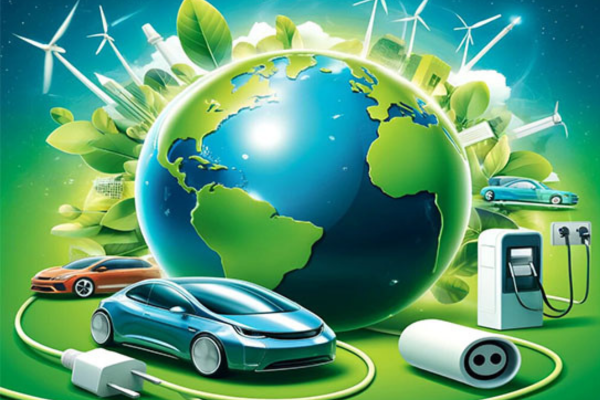A new chapter is unfolding in India’s story of development, helping to redefine its growth via the lens of sustainability. India is currently standing at the intersection of rapid expansion and environmental responsibility. As a result, India is facing the dual challenge of supporting growth while curbing its contribution towards global emissions.
As India speeds up its transition to electric mobility, the shift represents more than just alignment with global trends, signalling towards a strategic integration of clean technology with inclusive progress and sustainable development.
Today, electric vehicles are emerging as a catalyst for ecological transformation, embodying the commitment of India to balancing economic growth with environmental responsibilities.
By reducing vehicular emissions, decreasing reliance on fossil fuels, and fostering a green industrial ecosystem, the EV transition is marking a structural evolution. It is not merely a technological advancement, but a comprehensive convergence of mobility, energy, and sustainability, driving systemic change across sectors.
Cutting Emissions at the Source
Road transportation is responsible for a total of 14% of the world’s greenhouse gas emissions https://www.cenn.org/the-transportation-sector-emits-14-of-worlds-greenhouse-gas-emission/. Vehicular pollution in the urban centres contributes to the poor quality of air affecting public health, which further lowers the economic productivity.
Thus, by shifting to EVs, India can directly address this issue.
Electric vehicles, as they are powered by renewable energy or run on mixed grid energy, play a crucial role in cutting down vehicular emissions as they emit less carbon than their internal combustion counterparts. This will eventually lead to better breathing air quality, thus contributing directly towards Sustainable Development Goal 13 (Climate Action) and will also curb the environmental footprint of fuel extraction, transport and refining.
Driving Decarbonization at Scale
The commitment of India to net-zero emissions by 2070 requires a whole new approach, with mobility and energy playing crucial roles. Thus, EVs are serving as a bridge between the two. As the power sector decarbonises through solar, hydro and wind projects, the electrification of transport exemplifies the climate benefits.
The adoption of EVs is supported by a comprehensive policy that includes production-linked incentives for the manufacturing of batteries, phased adoption for clean fleet targets, and urban transport electrification, creating a virtuous cycle.
A Green Industrial Ecosystem
The revolution in India due to EV is catalysing the new industrial ecosystem in India, green by design. The shift from battery production and recycling to the development of software and the deployment of infrastructure is driving innovation across all sectors. This has led to deeper research into alternatives such as sodium-ion and solid-state batteries, and not lithium-ion batteries. The compounding investments in the sector of skill development are preparing the workforce to meet the increasing demands of clean technology.
These developments are positioning India as a consumer of EVs as well as a hub for sustainable mobility innovation.
Urban Transformation Through Clean Mobility
With cities becoming the focal point, the culmination of electric mobility into urban planning is proving to be transformative. The electrification of public transport systems, supported by smart charging infrastructure, has been responsible for reducing the traffic-related emissions and is quietly contributing to efficient and healthier environments.
The rise of shared services – from two-wheelers to buses – has also redefined access to transport by reducing the cost of daily commutes and supporting inclusive urban development. This is now becoming a cornerstone of the smart city vision: connected, liveable, and sustainable.
Aligning with Global Climate Frameworks
The progress of India’s EV aligns directly with the global frameworks, for example, the Paris Agreement, which calls for a reduction of 45% in global emissions by 2030. The projections by the International Energy Agency (IEA) say that the global sales need to reach 60% by 2030 to remain on track for net-zero by 2050. Also, the Nationally Determined Contributions (NDCs) of India lay special emphasis on the decarbonization of transport. By accelerating the adoption of EVs, India can contribute meaningfully to this mandate.
Overcoming Challenges with Strategic Vision
No transition is without challenges.
The revolution is also facing hurdles due to high upfront costs, increasing gaps in infrastructure, and dependencies of the supply chain on non-technical minerals. However, strategic investments and public-private collaboration are helping India overcome these.
A Climate-Conscious Growth Story
The narrative of India’s EV transition is not just about replacing fuel tanks with batteries but is a story of progress in the sectors of technology, environment and economy, illustrating how a developing economy can leapfrog traditional industrial models and adopt a cleaner and smarter path in the 21st century.
The journey of India reflects a deepening awareness that climate action and economic ambition are intertwined priorities, and not opposing forces.
As the world accelerates toward its 2030 and 2050 climate targets, the importance of bold, scalable, and inclusive solutions cannot be overstated. India’s electric mobility revolution offers precisely that path from pollution to progress, from challenge to opportunity.

By Yogesh Bhatia, MD, and CEO of LML.

















